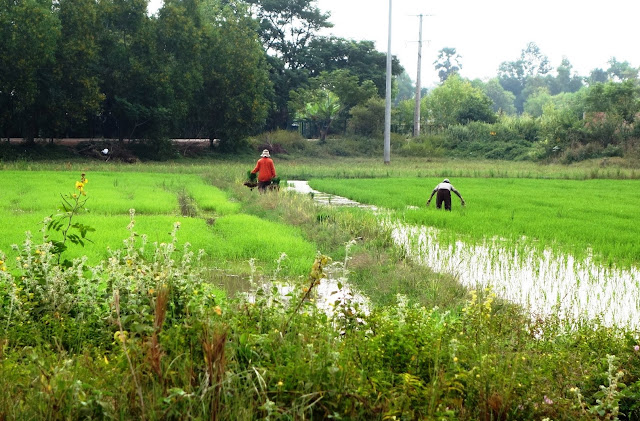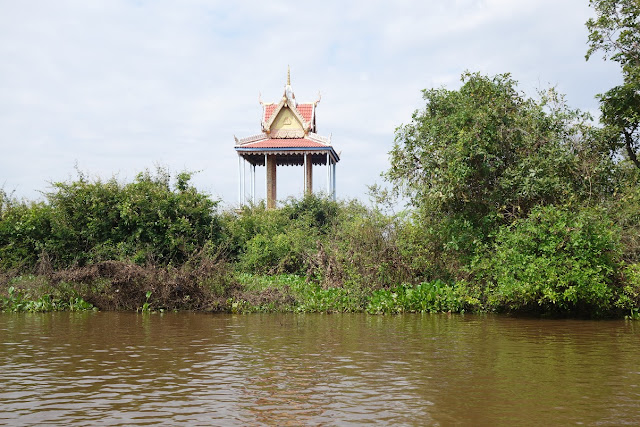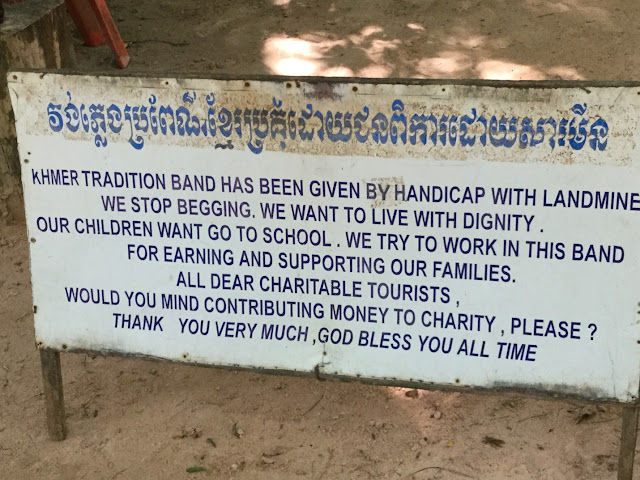Our first stop along the the way was to see a man standing in a canal next to the river, fishing with a net.
He was catching snakehead fish and other small fish that can survive a bit on land. The snakehead fish breathes air through its gills, so it can migrate short distances over land. They are invasive, and although they are native to Asia, especially China, some have made it to the southern US.
Then we headed out for an ox cart ride. Notice the baby buffalo by its mom in the cart behind us.
Our driver was definitely one of the older ones and very smiley...but probably just in his 40s.
We passed by many rice fields, such as the one below where people were working in the fields.
Most of the houses were on stilts with the bottom area empty because of flooding during the rainy season. This was an average house along the way.
A nicer home below with chickens too.
We passed the secondary school and also the community health center.
Our driver smiling for his photo. His clothing was tattered and he definitely appreciated the tip we gave him.
On our way to the river, we made a bathroom stop where a family ran three "happy rooms." The kids had fun with us (before asking for dollars--the unofficial currency of Cambodia), and I got a great picture of them.
The sign below was at a local restaurant we stopped at -- a regular toilet and not an outhouse/port-a-potty.
Then we headed up the river in a large motor boat to see a small fishing village of about 200 people.
Along the way we stopped to see lots of lotus flowers in bloom. Thanks to Jimmy for some of the great close ups of the flowers.
Niwat demonstrating how parts of the lotus can be used:
The lotus leaves can be worn as protection from the sun.
Here is the bus below that the 29 of us plus guides Niwat and Khan (from Vietnam) traveled on in Cambodia,
And here is the motor boat we took down the river.
On the boat. It was a bit dusty at the beginning (so some wore masks) and noisy.
Over 3,000,000 of Cambodia's 16,000,000 people live in such villages and work catching fish. (Before the Kymer genocide, there were 8 million people in Cambodia. About two million died, others fled, and amazingly there are now sixteen million in the country.)
When we headed out from our dock, the river was very muddy as it was quite shallow. The dock used the previous week was no longer in use because the river is almost non-existent at that spot at this time of year.
The plants below would soon be in dry land, but they can survive in both on dry land and in the river, often totally covered.
A shrine on the river, still in a somewhat muddy area.
When we got close to the village we were to visit, we found that in the past few days, most had taken the half-day journey two miles upriver.
In the rainy season about July, they move up river. And as the water recedes and gets dangerously low, making it hard to catch fish, they move down river where the water is deeper at the end of November. Since we were there on November, 20, it was just about the time for them to move.
Look at how much wider the river became as we moved up river to the deeper part.
Getting close to the new mooring site.
The houses are on pontoons of styrofoam or of empty petrol cans and are anchored in such a way as to stay in place..
Below, a woman is selling cooked food from the front of her home to passersbys.
It takes a half day for a house to be pulled the two miles by a motor boat. The house sometimes has an attached garden which also needs to be pulled. The house below has a garden in the middle, and probably a few chickens in the structure on the left.
A nicer garden below
The plastic covered area is the "happy room." There are plants in the water that disinfect it from the wastes of humans and animals. Note the empty oil cans under the house to keep it afloat..
Children boat to and from their tiny local primary school for first through six grades. Sometimes they paddle themselves and other times family members take them in motor boats.
Many do not study more as the next level school is far away and they would have to board. Even if they could afford the cost, most do not want their young children to be separated from them during the week.
The children also have a floating covered basketball court in the neighborhood. Children boat over there to play and get exercise.
Some of us crawled to and sat on the bow of the boat and had our pictures taken by Niwat. A few brave souls went up from there to the roof above.
A woman going from home to home selling a variety of goods:
See the cell phone tower below.
A storefront below
Homes spread out in the new site below.
After lunch, we stopped briefly at the Ankhor National museum. The highlight was to see the room with a thousand Buddhas. Unfortunately for us we could not take pictures of the statues to protect them. Many smaller ones were in cases. .
Angkor Wat, "The Heaven on Earth," is highlighted in Gallery D, one of eight galleries. It is the most significant example of the earthly paradise. Its unique architecture still astonishes engineering specialists today.
We went into Gallery A, which highlighted the origin and development of the Khmer Civilization/Emperor.. Unfortunately because we were running late and had to catch a plane, we could not see more. Gallery B focused on Khmer's Religion and Beliefs, and Gallery C focused on the four Great Khmer Kings, the great inventors. Gallery G was a shame to miss--the Fascination of apsara and ancient costumes.
We did see a few other things and a bit of history of Cambodian religion.
 |
| Floor plan of the museum |
Below, a beautiful piece of Kantha art depicting woman in leisure and in religious practice.
Sunset at the Siem Reap airport as we fly out to Saigon/HCMC (Ho Chi Minh City)



































































































